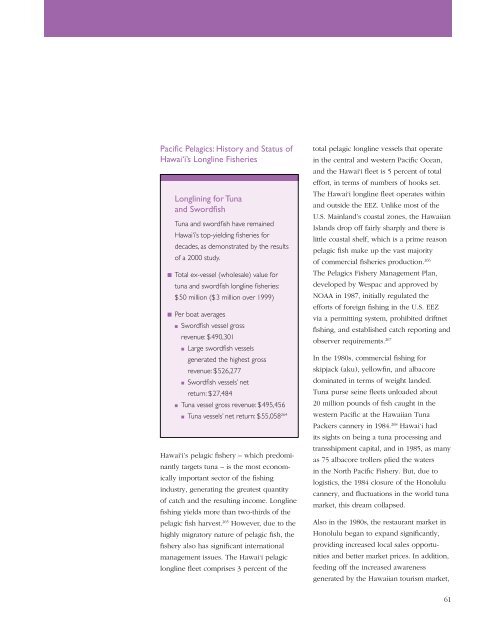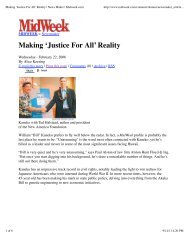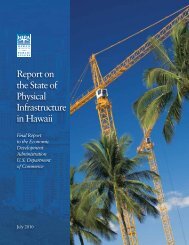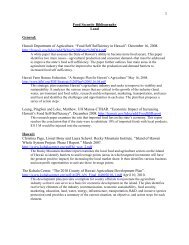Hawai'i Fisheries Initiative - The Hawaii Institute for Public Affairs
Hawai'i Fisheries Initiative - The Hawaii Institute for Public Affairs
Hawai'i Fisheries Initiative - The Hawaii Institute for Public Affairs
Create successful ePaper yourself
Turn your PDF publications into a flip-book with our unique Google optimized e-Paper software.
Pacific Pelagics: History and Status of<br />
Hawai‘i’s Longline <strong>Fisheries</strong><br />
Longlining <strong>for</strong> Tuna<br />
and Swordfish<br />
Tuna and swordfish have remained<br />
Hawai‘i’s top-yielding fisheries <strong>for</strong><br />
decades, as demonstrated by the results<br />
of a 2000 study.<br />
n Total ex-vessel (wholesale) value <strong>for</strong><br />
tuna and swordfish longline fisheries:<br />
$50 million ($3 million over 1999)<br />
n Per boat averages<br />
n Swordfish vessel gross<br />
revenue: $490,301<br />
n Large swordfish vessels<br />
generated the highest gross<br />
revenue: $526,277<br />
n Swordfish vessels’ net<br />
return: $27,484<br />
n Tuna vessel gross revenue: $495,456<br />
n Tuna vessels’ net return: $55,058 264<br />
Hawai‘i’s pelagic fishery – which predominantly<br />
targets tuna – is the most economically<br />
important sector of the fishing<br />
industry, generating the greatest quantity<br />
of catch and the resulting income. Longline<br />
fishing yields more than two-thirds of the<br />
pelagic fish harvest. 265 However, due to the<br />
highly migratory nature of pelagic fish, the<br />
fishery also has significant international<br />
management issues. <strong>The</strong> Hawai‘i pelagic<br />
longline fleet comprises 3 percent of the<br />
total pelagic longline vessels that operate<br />
in the central and western Pacific Ocean,<br />
and the Hawai‘i fleet is 5 percent of total<br />
ef<strong>for</strong>t, in terms of numbers of hooks set.<br />
<strong>The</strong> Hawai‘i longline fleet operates within<br />
and outside the EEZ. Unlike most of the<br />
U.S. Mainland’s coastal zones, the <strong>Hawaii</strong>an<br />
Islands drop off fairly sharply and there is<br />
little coastal shelf, which is a prime reason<br />
pelagic fish make up the vast majority<br />
of commercial fisheries production. 266<br />
<strong>The</strong> Pelagics Fishery Management Plan,<br />
developed by Wespac and approved by<br />
NOAA in 1987, initially regulated the<br />
ef<strong>for</strong>ts of <strong>for</strong>eign fishing in the U.S. EEZ<br />
via a permitting system, prohibited driftnet<br />
fishing, and established catch reporting and<br />
observer requirements. 267<br />
In the 1980s, commercial fishing <strong>for</strong><br />
skipjack (aku), yellowfin, and albacore<br />
dominated in terms of weight landed.<br />
Tuna purse seine fleets unloaded about<br />
20 million pounds of fish caught in the<br />
western Pacific at the <strong>Hawaii</strong>an Tuna<br />
Packers cannery in 1984. 268 Hawai‘i had<br />
its sights on being a tuna processing and<br />
transshipment capital, and in 1985, as many<br />
as 75 albacore trollers plied the waters<br />
in the North Pacific Fishery. But, due to<br />
logistics, the 1984 closure of the Honolulu<br />
cannery, and fluctuations in the world tuna<br />
market, this dream collapsed.<br />
Also in the 1980s, the restaurant market in<br />
Honolulu began to expand significantly,<br />
providing increased local sales opportunities<br />
and better market prices. In addition,<br />
feeding off the increased awareness<br />
generated by the <strong>Hawaii</strong>an tourism market,<br />
61







